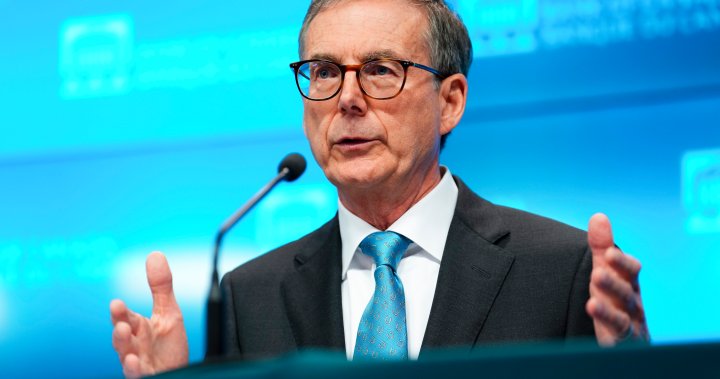After Bank of Canada’s oversized cut, is lower and faster the new pace? – National

The Bank of Canada delivered an oversized interest rate cut of half a percentage point on Wednesday, focusing now on boosting the Canadian economy amid signs inflation is well under control.
The central bank’s policy rate now stands at 3.75 per cent. Wednesday’s decision is the fourth consecutive drop in interest rates since June and is the Bank of Canada’s largest rate cut since the global financial crisis in 2009, outside the COVID-19 pandemic.
“We took a bigger step today because inflation is now back to the two per cent target and we want to keep it close to the target,” Bank of Canada governor Tiff Macklem told reporters Wednesday.
Since the previous interest rate cut in September, inflation has not only returned to the Bank of Canada’s two per cent target but even dropped below it to 1.6 per cent in the most recent reading.

The Bank of Canada’s revised outlook has inflation holding around the two per cent mark in the foreseeable future, allowing for some fluctuations within the target range of one to three per cent.
But with inflation largely tamed the central bank’s focus is shifting to cracks that have formed in the Canadian labour market and the broader economy. The unemployment rate remains elevated at 6.5 per cent and growth in the third quarter has significantly undershot the central bank’s previous estimates.
The Bank of Canada is hoping that cuts to the policy rate will encourage growth, making it easier for Canadians and businesses to spend and boost the economy.
TD Bank was among a minority of forecasters calling for a 25-basis-point cut on Wednesday, a more typical step in line with the three preceding moves.
James Orlando, the bank’s director of economics, told Global News in an interview that the Bank of Canada felt it needed to be “more aggressive” amid inflation’s sharp drop, which was owed largely to cheaper gas prices.
But he says no matter how large the October cut was, the trends in Canada’s economy remain the same, and a difference of 25 basis points won’t change any of those realities for Canadians.
“They cut by 50 today. They could have cut by 25. It’s not going to change things on the margin, we still have Canada currently being an economy that is struggling and we need more help,” Orlando said.
What comes next for the Bank of Canada?
Macklem said that if the economy continues to evolve broadly in line with the central bank’s expectations, more interest rate cuts can be expected to boost demand and keep inflation on target. But he pushed back on reporters’ efforts to get more clarity on the pace of future interest rate cuts.
“I think we’ve been pretty clear on the direction,” he said Wednesday. “I think we’ve been pretty clear that the timing and the pace is going to depend on how the data evolves.”

Get weekly money news
Get expert insights, Q&A on markets, housing, inflation, and personal finance information delivered to you every Saturday.
The Bank of Canada’s final interest rate decision of the year is set for Dec. 11.
CIBC assistant chief economist Avery Shenfeld called the 50-basis-point step a “no-brainer” in a note to clients Wednesday, adding that “it would take a significant turn of events to stand in the way of another cut of that magnitude in December.”
But not all economists are reading the Bank of Canada’s tea leaves in the same way.
BMO chief economist Doug Porter said in a note that he believes a return to quarter-point cuts might be in store for the next meeting. He argued that the Bank of Canada’s overall forecasts for the economy have not shifted much in the long term, and there’s nothing in the central bank’s messaging that suggests anything more than mild easing unless upcoming economic data comes in much weaker than expected.

While the central trimmed its expectations for real gross domestic product growth this year to 1.8 per cent, down from two per cent, the broader horizon held relatively steady. The Bank of Canada now foresees real GDP growing at an annual pace of 2.3 per cent in both 2025 and 2026.
“Given the relatively modest adjustment in the bigger picture outlook on the economy, this forecast hardly calls out for urgency for additional large rate cuts,” Porter said.
Financial markets have fully priced in a 25-basis-point cut in December, with one-in-four odds of another 50-basis-point step as of Wednesday, according to Reuters.
Orlando agreed that the next rate cut is up in the air. While he predicts a quarter-point cut to follow, weaker data on the inflation or jobs front could set the Bank of Canada up for another oversized step.
He argued that the lack of forward guidance from the central bank is likely intentional, but added that there should be no confusion about the direction; TD Bank has pencilled in an additional 150 basis points of easing in the next year.
“We really don’t know, and I don’t think the Bank of Canada knows what it’s going to do either,” Orlando said. “All we know is that rates are likely to keep going down. Whether it be 25, 50, 75, who knows. But they’re going down, which is the direction we need them to.”
Jumbo cut represents a ‘sigh of relief’
The Bank of Canada’s key rate informs rates that lenders offer on many loans, particularly mortgages. Wednesday’s sizeable interest rate cut offers immediate relief to Canadians with variable rates of interest and bodes well for those with mortgages coming up for renewal.
Macklem said that he expects Wednesday’s rate cut will lead to a boost in spending among both consumers and businesses.
He acknowledged, however, that slowing inflation and lower interest rates do not erase the run-up in prices the Canadians have contended with since the COVID-19 pandemic.

With there are still some areas of the consumer basket that continue to experience pressure, such as shelter costs, the head of the Bank of Canada said that he felt Canadians could “breathe a sigh of relief” now that the future pace of price hikes looks to be more predictable.
“It’s been a long fight against inflation. But it’s worked,” Macklem said.
“With inflation staying close to two per cent, Canadians don’t have to worry about big changes in their cost of living. Yes, they’ve got lots of other things to worry about. This is one less thing to worry about.”
The Bank of Canada’s latest monetary policy report also projects a recovery in home sales and a boost in prices tied to lower interest rates. Declining borrowing costs might also help to get more homes in Canada built, the report noted, but demand is still expected to outpace supply amid persistently tight inventories across the country.
The central bank’s report specifically highlights Ottawa’s upcoming mortgage changes to make insured mortgages and longer amortizations more widely available as likely to drive more activity in the housing market in 2025.

Orlando said this is an area he thinks the Bank of Canada needs to keep a close eye on as it gauges the pace for rate cuts.
Despite some marginal improvements, housing remains largely unaffordable in Canada.
While lower borrowing costs make it easer for Canadians to qualify for a mortgage, Orlando noted that a rapid pace of rate cuts can trigger a “recoil mechanism” that can end up exacerbating the problem. FOMO, or a fear of missing out, can drive more buyers back to the market, sending prices jumping higher and further eroding affordability.
The Bank of Canada ought to consider how the pace of its rate cuts could, in conjunction with Ottawa’s mortgage changes, charge up activity in the upcoming spring 2025 housing market, Orlando said.
The central bank itself acknowledged that a stronger-than-expected rebound in housing activity could see it slow or even pause the pace of easing, according to deliberations released after its September interest rate cut.
There are risks on the other side of the equation too, however, associated with not lowering interest rates fast enough. If businesses hold back investment, Canada’s labour market may deteriorates further. Should layoffs pick up, “that’s the really big risk to Canada,” Orlando explained.
While the Bank of Canada appears to have stuck the “soft landing” — taming inflation without sending the economy into a recession — Orlando said that doesn’t mean the job’s done.
“Risks are balanced right now, but things can change. There’s a lot of risks on the horizon,” he said.
— with files from Reuters








